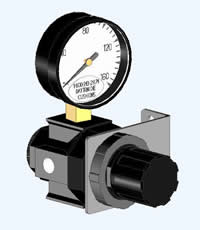|
|
|
Die cushion operation is quite straightforward.
Standard pneumatic die cushion is pushed down by the ram through
pins that rest on the top of the pin pad and then it returns to
its upper stop position (usually bottom of the bolster or cushion's
stop rods) by following the ram movement up during return part of
the stroke. However there are few concepts that should be mentioned
in regards to die cushion operation:
1.Die cushion tonnage
|
| System pressure defines the die cushions tonnage that
it will develop during the stroke. Die cushion tonnage is rated at
the maximum allowed pressure and at the top of the stroke. Generally
pneumatic die cushions are rated to 100 or 200 psi. They can develop
less than rated tonnage by adjusting system pressure to the number
lower than the maximum pressure. Tonnage-pressure relation is proportional
so if for example die cushion develops 10 tons at 100 psi, it will
develop 5 tons at 50 psi. Also, system pressure increases slightly
during the stroke (by no more than 15%), so it is higher at the bottom
of the stroke. |
| In order to regulate pressure in low pressure die
cushions (operating at maximum 100 psi), one should use regulator
and gauge assembly and just shut off regulator inlet port (by turning
regulator knob) when the system reaches desired pressure. Similarly,
for high pressure die cushions (200 psi maximum), regulator on the
booster pump should be closed once the system pressure is at desired
level. |
 |
2.Correct die pin placement
It is critical to evenly load the die cushion's pin pad to prevent
so-called off-center loading and cocking of the cylinder-piston assembly.
Even distribution of pins throughout the pin pad and use of compensating
pins will help accomplish this.
3.Lubrication
To ensure proper die cushion functioning, prevent galling and scoring
of the cylinder-piston bearing surface and other mechanical damage,
die cushions should be lubricated after every 8 hours of operation.
4.Draining the die cushion
Die cushions and surge tank should be drained daily to remove any
accumulated moisture inside the system. It is important as it could
reduce system surge volume and result in too high of the pressure
build-up (above safety limits). Some model D die cushions are not
supplied with the surge tank. In this case drain cock should be installed
directly on the cushion. Otherwise, drain cock should be installed
at the low point of the system and on the surge tank. |
|
|
|
 Dayton
Die Cushions
Dayton
Die Cushions Dayton
Die Cushions
Dayton
Die Cushions